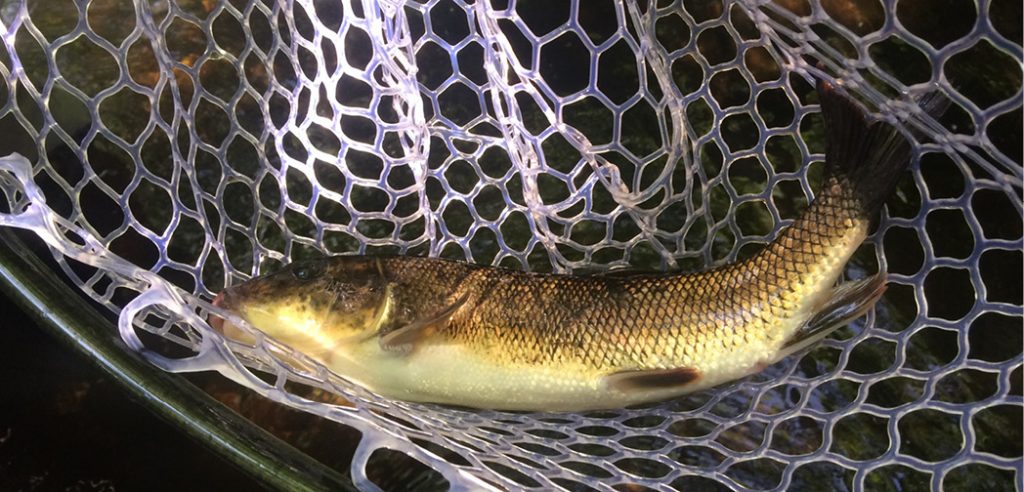By Anthony Allen, Save the Sound Ecological Communications Specialist
Editor’s note: We’re pleased to introduce this new monthly feature, which will be written by our friends at Save the Sound. To learn more about this vital organization’s work, and take action for a clean and healthy Long Island Sound, visit savethesound.org.

Jon Vander Werff, Save the Sound’s Fish Biologist, uses to catch-and-release traps to count migratory fish on waterways flowing to Long Island Sound. ©savethesound.org
Every spring, our region witnesses one of Earth’s wonders as hundreds of thousands of fish crowd into rivers across the Long Island Sound region, making the harrowing journey upriver using smell to locate the stream or pond where they were born. Once there they will reproduce and lay eggs, ensuring the continuity of this mysterious and beautiful cycle of life. It’s the spring fish run, and this year Save the Sound was watching more closely than ever.
Rain or shine, five or six days a week, Save the Sound’s Fish Biologist Jon Vander Werff trekked out to local waterways to count fish using catch-and-release traps. Installed in late March, most employ a “run-of-river” design Jon has refined over the years. These traps are strategically placed at points where converging currents and fast-moving water produce higher levels of dissolved oxygen. Fish seek out these conditions, and are funneled into the trap from downstream, where they can be counted and then released.
Migratory species Jon monitors include alewife, blueback herring, American shad, gizzard shad, and sea lamprey. Save the Sound is principally interested in alewife, since these little fish play a critical role in the ecosystem. As forage fish near the bottom of the food chain, alewife are a critical food source for a wide range of species, including striped bass, osprey, otters, raccoons, and bald eagles. In fact, on average only one in 80,000 eggs will survive long enough to complete the outmigration to Long Island Sound as a juvenile alewife. Those that do help to transport nutrients from freshwater ecosystems to the open waters. Three to five years later, their journey back to their place of birth serves the same function in reverse.
Save the Sound installs and monitors fish traps either upstream of a site where we have completed a fish passage project (to monitor the return of migratory species) or downstream of a planned fish passage project (to establish the presence or absence of target species before project completion). In 2017, Save the Sound was awarded funding from U.S. Fish and Wildlife Service to support monitoring for up to five years at Hurricane Sandy Restoration and Resilience Fund sites. In 2020, six sites across Connecticut were monitored by Save the Sound with support from Connecticut Department of Energy and Environmental Protection’s Inland Fisheries Division.
The data collected through these monitoring efforts tell a story of revival in our regions’ waterways.

An alewife © savethesound.org
The largest alewife migration in Connecticut happens each year at Bride Brook in Rocky Neck State Park, where Save the Sound led a culvert replacement project in 2009. Prior to that project, the annual run peaked just shy of 130,000 alewives, often lower. The first two runs after the culvert replacement were significantly higher, and 2020 set a new record, with 409,115 alewives passing through the culvert on their journey up Bride Brook.
However, monitoring results often fluctuate from year to year. In 2018, three years after Save the Sound led the removal of the Hyde Pond Dam in Mystic, CT, the trap there caught 1,284 alewife. Last year, just 42. And this year, 325. Such fluctuations aren’t uncommon, and can be caused by temperature patterns, amount and timing of rainfall, and any number of other factors that affect conditions in Long Island Sound and its rivers.
One of the most exciting parts of the fish run is documenting migratory species for the first time in a location previously rendered inaccessible or assumed to be so. On Haley’s Brook in Groton, CT this year, alewives were recorded upstream of two culverts thought to be impassable. An alewife was also documented at the base of a dam below Pelham Lake on the Hutchinson River in Westchester County for the first time, a significant finding given that river’s ecological challenges.
While the 2020 fish run has come to an end, the work of restoring passage to ancestral habitat for migratory fish continues. Save the Sound is advising on the removal of the Pelham Lake Dam, and has several other barrier removal and fish passage construction projects in progress across Connecticut and New York. After all, with so few alewife surviving to adulthood, the last thing these fish need is man-made barriers blocking their journey home.
As for all of us, we can find encouragement in the resilience of nature, so well exemplified by the persistence of these small fish and the health of the 2020 fish run. ■




